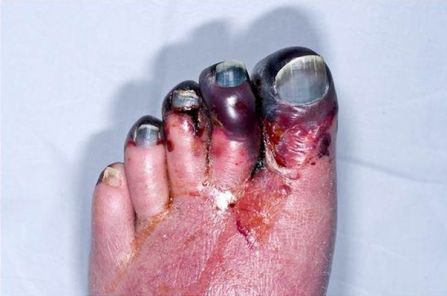Complications
The risk of major bleeding during treatment with nonheparin anticoagulants varies significantly according to the agent used and patient comorbidity (estimated range 3% to 14%).[44]
Limb amputation is required in 6% to 10% of patients with confirmed HIT.[56]
To date, none of the nonheparin anticoagulants have been shown to reduce the risk of amputation in a patient with limb ischemia secondary to HIT-provoked macro- and microthrombosis.
In the past, when vitamin K antagonists (e.g., warfarin) were used for treatment of HIT without concurrent coverage with a nonheparin anticoagulant, protein C levels would fall faster than prothrombin levels, which induced a prothrombotic state. This can lead to serious adverse events, such as warfarin-induced skin necrosis and venous limb gangrene (distal ischemic limb necrosis in the absence of arterial occlusion). [Figure caption and citation for the preceding image starts]: Venous limb gangrene of left foot in HIT (dorsal aspect)Rozati H, Shah SP, Peng YY. Lower limb gangrene postcardiac surgery. BMJ Case Reports. 2013; doi:10.1136/bcr-2012-008362 [Citation ends].
Use of this content is subject to our disclaimer